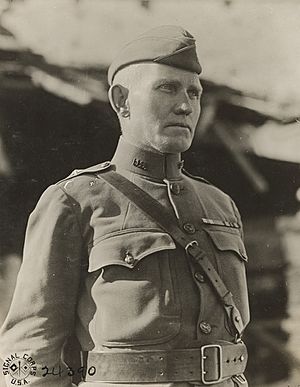Ewing E. Booth facts for kids
Quick facts for kids
Major General
Ewing E. Booth
|
|
|---|---|

Brigadier General Booth in Haudainville, September 1918
|
|
| Born | February 28, 1870 Bowers Mill, Missouri |
| Died | February 19, 1949 (aged 78) Chevy Chase, Maryland |
| Allegiance | |
| Service/ |
|
| Years of service | 1898–1934 |
| Rank | |
| Awards |
|
Ewing E. Booth (born February 28, 1870 – died February 19, 1949) was an important general in the United States Army. He served his country in two major conflicts: the Spanish–American War and World War I. For his bravery and leadership, he received several special awards, including the American Army Distinguished Service Medal and the French Croix de Guerre.
Contents
Early Life and Family
Ewing E. Booth was born in Bowers Mill, Missouri, on February 28, 1870. His parents were Nathaniel and Martha Bower Booth. In 1892, he married Elizabeth "Lizzie" Williams. They had one daughter named Gladys.
Joining the Army
Booth began his military journey in 1893. He joined the Colorado National Guard as a private, which is the lowest rank for a soldier. By 1896, he had shown great promise and was promoted to second lieutenant, becoming an officer.
Serving in the Spanish-American War
During the Spanish–American War, Booth served as a captain. He was part of the 1st Colorado Volunteer Infantry. This war was fought in 1898 between the United States and Spain. Booth was honorably discharged from this role in July 1899.
Afterward, he continued his service with the 36th United States Volunteer Infantry until March 1901. In February 1901, he joined the famous 7th Cavalry Regiment as a first lieutenant.
Training and Promotions
Booth was dedicated to learning and improving his military skills. He graduated from the Infantry and Cavalry School in 1903. He then moved to the 10th Cavalry Regiment in August 1904, where he became a captain.
In May 1905, he returned to the 7th Cavalry. That same year, he completed his studies at the United States Army Command and General Staff College. This college helps train army officers for important leadership roles.
World War I Service
As World War I approached, Booth continued to rise through the ranks. He became a major in May 1917. He served as the Chief of Staff for the Army's Eastern Department for a few months.
In August 1917, he became a lieutenant colonel. He was then assigned to the new 77th Infantry Division as its Chief of Staff. By February 1918, he was a colonel, and by June 1918, he had become a brigadier general.
Key Battles in France
During World War I, General Booth commanded the 8th Infantry Brigade. This brigade was part of the 4th Infantry Division. He led his troops in several major battles in France:
- The Second Battle of the Marne in July and August 1918.
- The Battle of Saint-Mihiel in September 1918.
- The first part of the Meuse-Argonne Offensive in September and October 1918.
For his brave leadership in the Meuse-Argonne Offensive, he received the Army Distinguished Service Medal in July 1919. This is a very high honor given for outstanding service.
After the War
After the war ended in November 1918, Booth stayed in Germany with the American army that occupied the country. He then took on important roles in the Service of Supply, helping to manage army resources. He was even made Chief of Staff of all American Forces in France.
In 1920, he served as a deputy allied high commander in Armenia. This shows how important his leadership was on the world stage.
Post-War Career
After his time in Europe, Booth returned to the United States. He continued to serve in important positions:
- He became the assistant commandant, and later the director, of the Army's General Service School.
- From 1923, he taught at the Army War College, helping to train future military leaders.
- He commanded the 4th Cavalry Brigade and the 1st Cavalry Brigade.
- From 1925 to 1927, he was the commandant of the United States Cavalry School at Fort Riley, Kansas.
- From 1927 to 1931, he worked as an assistant and deputy Chief of Staff for the United States Department of War.
- In 1931, he took command of the 1st Cavalry Division.
- His final assignment was in the Philippines from 1932 to 1934.
Retirement and Passing
Ewing E. Booth retired from his long and distinguished military career on February 28, 1934. He moved to Los Angeles, California. After his wife passed away in 1943, he moved to Chevy Chase, Maryland, to be closer to his daughter.
General Booth died in Chevy Chase on February 19, 1949, just before his 79th birthday. He was buried with military honors at Arlington National Cemetery, a special place where many American heroes are laid to rest.

